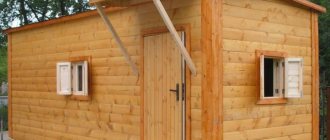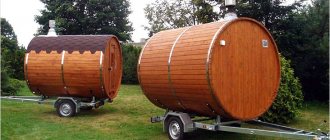At the dawn of capitalism in Russia, in the early 90s, a container was a measure of human well-being. The casually dropped phrase: “I have a container at the Cherkizovsky market” was guaranteed to mean that this was an enviable bride with a good dowry and bright prospects. Time passes, everything changes. Containers from market squares have quietly migrated to shabby dacha associations, where they serve as a place to store gardening equipment, and sometimes provide overnight shelter for a summer resident who is late in his work. In today’s material, we are trying on slightly different clothes for a strong iron box, and the semi-criminal phrase: “dress up in a wooden mackintosh” will sparkle with completely different, positive colors. Meet our today's heroine - a bathhouse made from a container.
What is the value of a container bath
Making a bathhouse from a container box is relatively easy. All you need to do is develop and plan:
- A system of powerful insulation of metal walls, otherwise in winter the sauna from a container will turn into a glacier covered with condensation, and in summer in the sun the temperature will easily reach 70 ° C;
- Ventilation diagram of the internal space and auxiliary insulation cavities;
- Water supply for shower and steam room;
- Installation of a stove or electrical heating connection for lamps and fan drives.
All this is not difficult to do, if not for one “but”. On the one hand, it is possible to sheathe or cover a metal box with bricks, SIP panels, aerated concrete slabs, and problems with room insulation and corrosion protection would be solved. But why then fence a garden with a heavy metal body? Offhand it turns out that it is cheaper to build a bathhouse without a container insert.
Most owners choose to build a bathhouse from a container, photo, if they require:
- Build a bathhouse with a strong frame for installation on heaving loams or sandy quicksand. Buying and building a full-fledged bathhouse from a 20 English foot container will cost less than the hassle of rearranging timber or log crowns;
- Make a small-sized steam room on wheels, which can be taken for a season to a vacation spot, to a country house, or to a full-scale construction site. A bathhouse made from a 5-ton container can easily fit in the back of a Bull or a Ford truck.
Important!
A container bathhouse does not require a full foundation, regardless of whether it is a bathhouse made from a 20-foot container, or whether it is planned to use several 5-ton boxes. A flat area filled with sand and gravel is sufficient. Several container boxes, one of which is allocated for a dacha, after finishing and connecting communications, can easily serve as a full-fledged country house.
If the five-ton truck is used as an extension to an ordinary country house, the task can be simplified. For example, make only a steam room out of a container, and use the premises of a country house for relaxation and washing.
After trimming the side walls, the container body can become a frame for arranging an ordinary stationary bathhouse, built in accordance with all the rules and laws of heating engineering.
To do this, you don’t need to purchase a new or a whole container; you can buy a box with holes in the walls literally for the price of scrap metal, and it will be cheaper than:
- Pour the foundation;
- Spend half a cube of high-quality timber on the arrangement of racks and the upper and lower frame of the frame of the future bathhouse.
It will only be necessary to insulate the bathhouse on a container frame and veneer it both on the inside and on the outside of the building.
Preparatory work
Before delivery and installation of the metal module, it is necessary to prepare the site: clear and determine the soil characteristics. If the soil is not strong enough, arrange a compacted crushed stone-sand cushion, on which supports are then installed. The installation of supports is mandatory because, thanks to the gap between the bottom of the module and the ground, the necessary ventilation is ensured. Thanks to the circulation of air masses, the bottom of the metal container does not rot or become affected by mold.
The following are used as supports:
- Wood blocks treated with special compounds to increase resistance to moisture and aggressive biological factors.
- Brick pillars.
- Cinder blocks. This is an undesirable option, since cinder blocks without an external protective coating are quickly destroyed by moisture.
When using bricks or cinder blocks, they are laid on a cement-sand composition. A frame made of timber with a cross-section of 150x150 mm is installed on the supports, on which the container is installed. At the stage of preparing the site for the module, the location of the main zones of the bathhouse is determined for the purpose of optimal installation of water supply and drainage systems.
Attention! The bathhouse must be located at a distance of 20 m from the road, 5 m from the neighboring plot, 4 m from the residential building. The structure is mounted with a slope towards the shower and steam room, which ensures uniform drainage of water.
Container bath problems
Most developers planning to build their own bathhouse on a suburban site pay increased attention to container-based steam rooms and sauna projects. Often, three factors, which many private owners are familiar with only through rumors, keep them from building a bathhouse from a container with their own hands:
- Significant cost of implementing a bathhouse project from a container;
- The metal of the case is subject to severe corrosion;
- In the summer, the interior of the steel container turns into a stove.
The main argument of opponents of the idea of building a steam room from a container is the rather small number of offers of a ready-made bathhouse from a 20-foot container on the real estate market. This is not entirely true. Firstly, most specialized construction companies offer custom-made bathhouses from a container according to a standard design. One of the options, costing about 500 thousand rubles, is given below.
Such a bathhouse made from a 20-foot container photo is divided into three rooms with an area of 10-12 m2:
- Steam room with electric stove;
- The second box is a dressing room and a washroom with a shower;
- The third room is reserved for a locker room and a rest room.
The internal space, 6 m long and 2.2 m wide, is lined with clapboard, the external walls can be finished with siding or block house. The price for a finished bathhouse from a 20-foot container is clearly too high, which limits the mass demand for the product.
Secondly, there is a certain shortage of sea containers on the market. Companies involved in the production of premises from sea containers buy them in small quantities from carriers. A new or three-year-old box in good condition will cost at least 40-50 thousand rubles. If you set a goal and build a bathhouse from a 20-foot container for yourself, then with some patience you can find a single box in good condition for 25-30 thousand rubles.
Heating device
At the bathhouse design stage, it is worth considering what energy source we will use. This is an important point, because you will need to think about how energy will be supplied and by what methods. Bath boilers are of the following types, namely:
- Electrical.
- Woody.
Depending on the size of the container, 5-20 or 40 pounds, the actual heat source is selected. I would recommend a wood-burning stove, it warms up faster and is more efficient. Well, you should choose the size based on the size of the steel container that will be used as the frame of the building.
In order to provide the bathroom with hot water, it is worth considering in advance the plumbing methods for wiring from the boiler.
How to prevent corrosion
The metal of most container models has practically no special properties. To protect steel walls from moisture and salts, the surface is phosphated and treated with special primers. If you already have plans to build a bath complex, then it is best to equip the bathhouse with your own hands from a sea container.
Such a building will easily last a couple of decades, while ordinary container boxes can be subject to corrosion due to improper ventilation of the steam room and insulation.
Advice! The simplest way to protect a steel body from corrosion is to use zinc or magnesium anodes. The rods are buried in the ground to a depth of 50-70 cm, and the leads are soldered to the metal walls of the room.
conclusions
Thus, using a change house, you can get an excellent bathhouse, the price of which will be significantly lower than that of any capital option, and which at the same time will allow you to enjoy washing no worse than any other.
This sauna is suitable for several people; it is perfect for a personal plot, and that is why this type of bathhouse is often made specifically for dachas.
This technology has proven itself so well that similar bathhouses began to be produced at enterprises, literally on an industrial scale. But you can do it without problems and on your own, with only minimal skills. To do this, it will be enough to follow the instructions and do not forget about safety precautions.
Decoration of the facade of a container bath
The rectangular shape of the steel box simplifies the task somewhat. In the most budget-friendly option, the bathhouse body can simply be painted in a pleasant color, white or red. Light colors are very popular among developers in the southern regions, where it is important to combat the heat of the sun, which heats any metal in the summer. White paint reduces heat by 30-35%. If we add foil thermal insulation to this, then the problem of overheating can be considered solved.
The second most popular finishing method is wall cladding with a block house, wall paneling or regular siding.
If you add a roof and a wooden porch to the wooden cladding, you can successfully hide the very fact of using a container in the construction of a bathhouse under the outer cladding.
If the bathhouse is attached to the house, then it would be quite logical to line it with the same material as the main building. For country and mobile bathhouse options, it is best to limit yourself to painting the external walls. If the container is new, with factory paint, then such a three-layer coating will last much longer than a semi-handicraft repainting with automotive enamel.
Interior decoration
Internal work begins with the electrical connection and installation of water supply lines. The wiring is routed and hidden in protected boxes and cable channels. Next, you need to lay thermal insulation, vapor barrier and waterproofing in several layers over each floor. It goes without saying that the walls of the container must initially be cleaned with an anti-corrosion compound and treated with protective liquids. The “insides” of the bathhouse are finished with clapboard or timber. The owner determines the configuration of the sunbeds himself. The dressing room is also used to decorate the waiting room.
How to properly build a sauna from a sea container
Immediately after purchasing a 20-foot container, the first thing you need to do is check for damage to the walls and places with painted over, putty, rusty holes. A rusty hull costs half the price of a container in good condition, so owners widely use automotive putty and marine paints to mask problem areas. You can identify a hole in the wall with a magnet or a special device.
Which foundation to choose for a bathhouse - container
Despite the fact that a bathhouse can stand for many years even on a simple platform with crushed stone, most owners prefer to install it on a foundation.
A lightweight five-ton container for a steam room is usually installed on columnar supports cast in concrete formwork or built of brick. If the place for the bathhouse is chosen in the forest, or on the shore of a reservoir, then it is recommended to make a crushed stone cushion under the supports. To do this, dig mini-pits according to the number of pillars to a depth of 60-70 cm, fill them with a mixture of fine sand and gravel screenings. Such a foundation will support even a forty-foot container.
Often, the owners of a future bathhouse pour a slab foundation under the container block, motivating their decision with insurance against sagging of the building and the desire to install a second floor in the future. This is not the best option for a bathhouse. The container body is so strong that it will withstand even the collapse of 40% of the supports, and the concrete under the floor will require serious insulation of the bathhouse subfloor.
Insulation of container walls and ceilings
The main issue in building a bathhouse is always the choice of insulation method. At the first stage, the walls and ceiling are sheathed with wooden slats, providing a ventilation gap. Next, the material is selected.
Metal walls can be insulated in three ways:
- A multi-layer sandwich made of foamed foil polyethylene with an additional layer of aluminum foil laid on the crate;
- Stone fiber mats with a glued layer of foil film. This type of insulation is used exclusively in saunas;
- A “pie” of polyurethane foam from the inside of the container and polystyrene foam on the outer surface.
Thermal insulation based on polyethylene foam and stone fiber must be sheathed with a vapor barrier. A 20-foot container will require at least one and a half rolls of film.
The insulation layer is sewn up with a wooden lath; for a three-room bathhouse you will need at least 80 m2 of linden or ash finishing. The gap between the container wall and the fiber must be ventilated after each visit to the bathhouse.
You can insulate the container space by spraying polyurethane foam directly onto the metal and sheathing slats. Next, a layer of vapor barrier, film and decorative finishing are laid. In this case, the dew point moves to the metal surface of the container.
The most optimal insulation option is considered to be the internal lining of the steam room compartment of the container with stone fiber with an aluminum screen. Layer thickness is at least 50 mm. Next, the outer walls of the bathhouse are covered with penoplex, at least 50 mm thick. The facade of the container is plastered or covered with clapboard.
Arrangement of the bathhouse floor in a container version
Expanded polystyrene insulation is laid on the floor of the bathhouse, over which a screed with a thickness of at least 100 mm is poured. In shipping containers, the floor is almost always made of thick, moisture-resistant plywood; polystyrene foam and concrete screed can be laid directly on the plywood base.
The next step is to lay a layer of mastic waterproofing over the concrete, install larch logs and install a ventilation system for the underground space. A wooden floor is laid on the joists. Most of the water and condensation that gets on the floorboards will be removed from the subfloor by the ventilation system.
The floor in the dressing room is arranged in a similar way; in the locker room or rest room, you can lay tiles directly on the concrete screed, and a lower level of flooring will make cleaning the premises easier.
How to deal with condensation inside a bathhouse
The steel walls of a container can become a source of serious problems, primarily due to the metal’s impermeability to water vapor. Even with special treatment of metal parts under conditions of warm condensation and detergent vapors, pitting corrosion can form on the walls of the container. Especially if window openings were cut out, holes were drilled for screwing in self-tapping screws, and laying communications.
Wherever the protective coating has been damaged, the metal will rust. In addition, the wooden sheathing on which the entire internal lining is supported easily absorbs moisture even under a layer of varnish or oil impregnation.
There is only one way to prevent container corrosion - by providing effective ventilation. In fact, each room of the container is equipped with its own supply and exhaust ventilation, plus one system for ventilating the subfloor and places where condensation accumulates. Ventilation should be turned on every time lovers of light steam leave the bathhouse and the stove is extinguished. Due to the accumulated heat, the air accelerated by the fans effectively expels condensation at any air temperature outside the container.
Finishing the interior of the bathhouse
According to the standards, the requirements for cladding with wooden slats apply only to the steam room or sauna. In the Turkish bath, the walls of the hot compartment can be finished with ceramic tiles.
The dressing room with shower compartment is lined with wooden panels, clapboard or board. The space for the shower can be separated by a wall and tiled with ceramic tiles. The shower floor is equipped with a drain without a tray, or a plastic shower cabin is simply installed. All parts of the wooden finishing of the bathhouse must be treated with impregnation with fire-retardant additives.
How to properly install a stove in a steam room
Regardless of what type of heater, wood-burning or electric, will be used to heat the container sauna, it is necessary to measure or calculate the volume of the steam room. Based on the resulting cubic capacity, the thermal power of the heater required for the bath and its location are determined.
For a sauna built in a container, the most preferable option would be a wood-burning steel or cast iron heater. It will be difficult to heat the huge steel body of the bathhouse using electricity.
The location for installing the stove is selected next to the partition separating the rooms of the dressing room and the steam room of the bath. The housing is mounted closer to the wall of the container so as not to block the passage and simplify the removal of the pipe. In this case, part of the wooden cladding of the wall behind the stove is removed and replaced with heat-resistant tiles, and the base is laid out of it. A ventilation window is cut out in the wall next to the stove. The second window is cut into the opposite side of the bathhouse wall.
Features of choosing and installing a stove
Unlike traditional baths, where dozens of types of devices can be used, a compact steam room based on a metal frame can only function with a wood-burning or electric stove. In conditions of cramped free space, many install a compact metal tank. The easiest way is to buy a factory boiler: on the specialized market you can find small, convenient domestic and foreign models.
When choosing a place to install heating equipment, you need to take into account an important condition: heat under the influence of natural air movement must first be directed to the steam room. Therefore, it is recommended to install the stove in the area of the partition separating the washing room from the steam room. A gap of 20 cm must be left between the heating apparatus and the wall in order to comply with fire safety standards.











